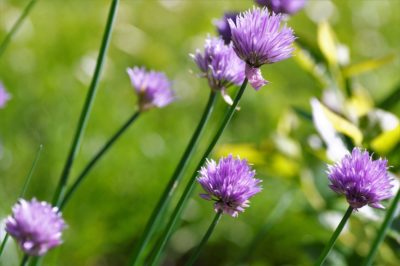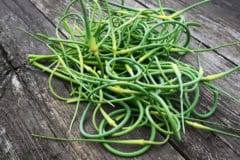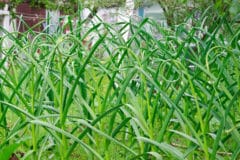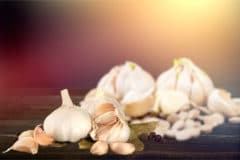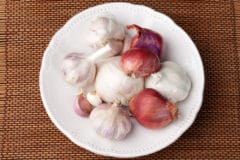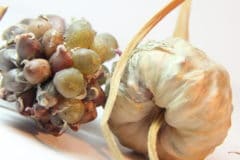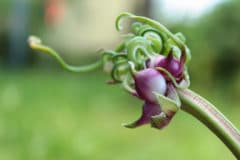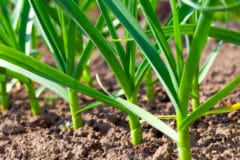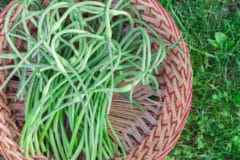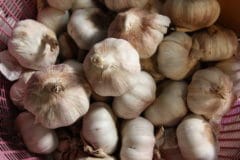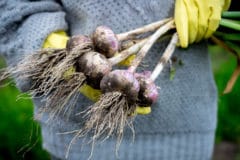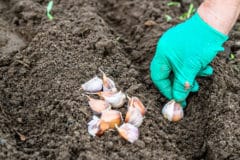What’s the Purpose of Garlic Flowers?
Even though it’s edible and prized in many recipes, garlic – strictly speaking – is not an herb or vegetable. It’s a flowering bulb, like daffodils or tulips. Like most flowering bulbs, it reproduces primarily through the bulbs. However, some garlics will also end up a flower stalk that can produce seeds. The seeds can be planted, although they typically don’t grow well and may be sterile.
–-Hardneck vs. Softneck Garlic
Garlic falls into one of two categories: hardneck or softneck. Most hardneck garlic will consistently produce flower stalks. Softneck, however, does not produce a flower stalk or seeds. Softneck garlics reproduce through their cloves. Softneck garlic stores longer, but hardneck has larger – although fewer – cloves. Hardneck garlic flavors are generally more complex and spicy. You can grow both in most climates.
What Varieties Should I Plant?
For flower production, you must plant hardnecks. You may have to search to find these varieties, with the exception of Chesnok Red and Red Czar. Some of the best varieties for flowering and seed production are:
- Bai Pai Suan
- Brown Rose
- Chimyon
- Darcheli
- Duganskij
- Krasnodar White
- Mexican Red
- Rosewood
- Shvelisi (aka Chesnok Red)
- Tien Shan
- Verchnjaja Mcara (aka Red Czar)
Should I Let My Garlic Plants Flower?
If your goal is large cloves, it’s better not to let garlic flower. Flowering diverts energy from the bulbs and into seed production. You can cut the immature flowering stalks (called scapes) and use them as you would cloves – they have a similar flavor. If you want actual garlic seed or want the flowers for another purpose, then let the plants develop flowers.
Can You Eat Garlic Flowers?
Garlic flowers are edible. They are best when immature or just beginning to bloom. As the seeds develop, the flower buds become hard and woody. Even though they are still edible, the texture is undesirable. If you choose to eat them, wash well – they readily harbor small insects and dirt. Sprinkle on salads or add to vegetable dishes.
Can Garlic Flowers be Dried?
Yes, garlic flowers dry quite well. Allow the flower head to develop until just before the seeds start to form. Cut stems near the base and wrap the ends with string or a rubber band. Hang the flower bunches upside down from a line strung in a warm, dry, airy place out of direct sunlight. It will take about a month for the flowers to dry completely.
Will Garlic Flowers Produce Seeds?
Different varieties of hardneck garlic may be better at flower and seed production than others. Since most growers don’t focus on flower and seed production, you may have to experiment. The Marbled Purple Stripe varieties of hardneck garlic are more likely to flower and to set seed. These varieties have a thick flower stalk, which holds up better in the garden. Belarus, Metechi, Northe and Khabar are varieties in this group.
How Do I Grow Garlic for Flowers?
Garlic is a heavy feeder, but once the cloves begin to develop, it needs less nitrogen. However, if you continue to give it more nitrogen, the plant will put more of its energies into flower stalk and leaf production. Side dress with 15-10-10 organic fertilizer by working one tablespoon per plant into the adjacent soil. You can also spray with fish or seaweed emulsion.
Can I Have Both Garlic Flowers and Cloves?
You can have both, but there are few caveats. Growing both flowers and cloves means the plant is dividing its energies. The cloves will probably not be as big or numerous. Give your plants the best chance by being meticulous about soil preparation prior to planting. Provide extra fertilizer for maximum nutrition. Never let the plants dry out – water any time the top inch of soil seems dry.
Do Garlic Flowers Come in Different Colors?
Garlic plants do have different colored flowers. Purple is a very common color, as is lavender. The anthers – the part of the plant that produces pollen – are often a different color or shade than the flower petals. Some garlic has purple anthers (these tend to produce more seed) with white, cream or pale pink flowers. Flower petals may also be subtly striped.
